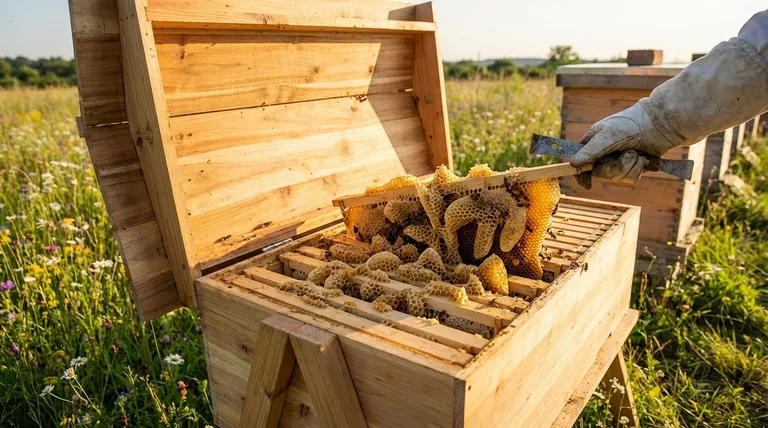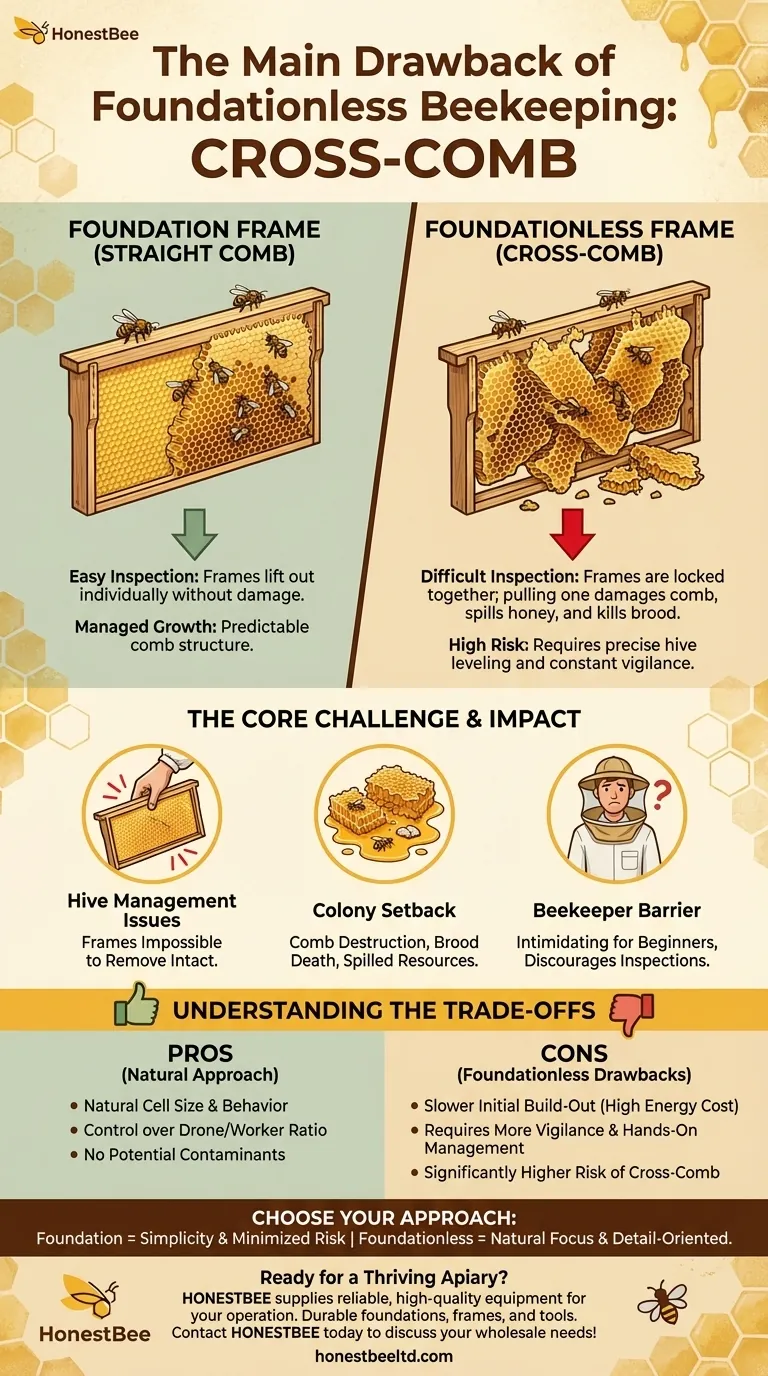The primary drawback of foundationless beekeeping is the significantly higher risk of bees building disorganized, unmanageable "cross-comb." This occurs when bees build their honeycomb across multiple frames instead of neatly within a single frame, making it impossible to inspect the hive without destroying comb, killing brood, and spilling honey.
While foundationless beekeeping empowers bees to build comb naturally, it shifts the responsibility of ensuring straight, workable comb from a pre-made wax sheet to the beekeeper's skill and attention. The central challenge is managing the risk of cross-comb.

The Goal of Foundationless Beekeeping
Foundationless beekeeping is a method where the beekeeper provides empty frames, allowing bees to construct their honeycomb from scratch without the guidance of a pre-imprinted "foundation" sheet of wax or plastic.
A More Natural Approach
The core philosophy is to let bees determine their own cell size and comb structure. This can result in smaller cells, which some believe may help disrupt the reproductive cycle of Varroa mites by shortening the development time of new bees.
How It Works in Practice
Instead of a full sheet of foundation, beekeepers use frames with a simple guide. This might be a wooden frame with a tapered top bar, a thin starter strip of wax, or even a line of popsicle sticks glued along the top bar to give the bees a straight line to follow.
The Core Challenge: Understanding Cross-Comb
When bees build comb, they are guided by gravity and the principle of "bee space"—the specific gap they prefer to leave between surfaces. If your guidance is insufficient, they can easily build in a way that creates problems.
Why Cross-Comb Happens
Cross-comb is most often caused by a hive that is not perfectly level. If the hive tilts to the side, the bees will still build plumb to gravity, causing their new comb to angle across the frames. It can also happen if frames are not spaced correctly, giving bees too much room to get creative.
The Impact on Hive Management
Correctly built comb allows a beekeeper to pull out one frame at a time to check the queen's laying pattern, look for pests, and assess honey stores. Cross-comb physically locks the frames together.
Attempting to pull a cross-combed frame will tear the comb from adjacent frames. This damages the colony's structure, spills valuable nectar, and kills the developing bees (brood) inside the cells, which is a major setback for the colony.
The Barrier for New Beekeepers
For a new beekeeper, discovering a hive full of cross-comb can be incredibly intimidating. Fixing it is a delicate and messy process, and the initial failure can discourage them from performing essential hive inspections in the future.
Understanding the Trade-offs
Choosing between foundation and foundationless methods involves a clear trade-off between convenience and a more natural approach.
Pro: Natural Cell Size and Behavior
By going foundationless, you allow bees to build the cell size they naturally prefer. This gives them control over the ratio of drone comb to worker comb and removes any potential contaminants present in commercial wax foundation.
Con: Slower Initial Build-Out
Building wax from scratch requires a tremendous amount of energy and nectar. A colony on foundationless frames will typically take longer to build out their hive compared to a colony that only needs to "draw out" the cells on a sheet of foundation.
Con: Requires More Vigilance
Foundationless beekeeping is not a "set it and forget it" method. It requires you to be proactive and diligent, especially when the bees are first starting to build new comb, to ensure they are building straight.
How to Apply This to Your Hive
Your choice should be based on your goals and your willingness to engage in hands-on management, particularly in the beginning.
- If your primary focus is simplicity and minimizing risk as a new beekeeper: Start with foundation. It provides a nearly foolproof way to get straight, easy-to-inspect comb while you learn the fundamentals of beekeeping.
- If your primary focus is natural beekeeping and you are detail-oriented: Foundationless is a rewarding approach. You must, however, ensure your hive is perfectly level and use strong comb guides to prevent problems.
Ultimately, successful beekeeping depends on understanding your colony's needs and providing the right structure for them to thrive.
Summary Table:
| Drawback | Description | Impact |
|---|---|---|
| Cross-Comb | Bees build comb across multiple frames instead of within a single frame. | Makes frames impossible to inspect individually without destroying comb. |
| Hive Management | Requires a perfectly level hive and precise frame spacing. | Demands high skill and constant vigilance from the beekeeper. |
| Colony Setback | Removing cross-comb kills brood and spills honey. | Significantly slows colony growth and can discourage new beekeepers. |
Ready to build a thriving, manageable apiary? Let HONESTBEE supply your operation with the reliable, high-quality beekeeping equipment you need. Whether you're a commercial apiary or a beekeeping equipment distributor, our wholesale-focused operations provide the durable foundations, frames, and tools for success. Contact HONESTBEE today to discuss your specific needs and get a quote!
Visual Guide

Related Products
- Long Langstroth Style Horizontal Top Bar Hive for Wholesale
- HONESTBEE Advanced Ergonomic Stainless Steel Hive Tool for Beekeeping
- Professional 3-Bar Frame Grip with Integrated Hive Tool
- Professional Dual-End Stainless Steel Hive Tool for Beekeeping
- Beehive Handle and Frame Rest Cutting Machine: Your Specialized Hive Machine
People Also Ask
- How are entrances designed in top bar hives? Master Beehive Layout for Maximum Honey
- How does the design of a top bar hive benefit beekeepers? Ergonomic & Natural Beekeeping for Hobbyists
- What are the benefits of the top bar hive? A Guide to Ergonomic, Natural Beekeeping
- What are the main differences between Langstroth hives and top bar hives? Choose the Right Hive for Your Beekeeping Goals
- What is a top bar bee hive? A Natural, Low-Stress Beekeeping Solution



















